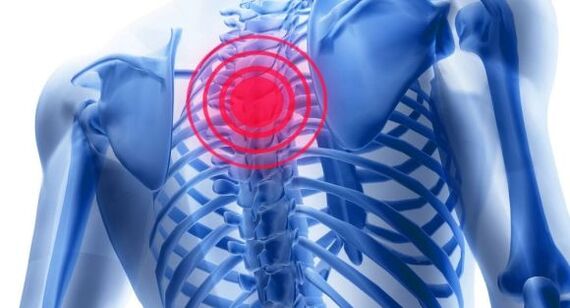
Chest osteochondrosis- This is a dysportic change in intervertebral discs, localized in the chest spine.The disease should be started immediately after the diagnosis, as the disease can quickly become chronic.
The main symptoms of the disease are limiting shoulder mobility, shortness of breath, stomach discomfort and chest pain that gives out the heart.The risk of the patient is that the symptoms of osteochondrosis are often confused with cardiovascular disease, so therapy is caused by a bad illness.
Causes of osteochondrosis
Chest osteochondrosis is a result of abnormal changes in vertebrae and intervertebral discs, as well as blood supply and nutritional damage.In addition, the disease can be caused by deformation of the spine.
Especially often, people in sedentary situations suffer from the breast osteochondrosis symptoms.Basically, these are office workers and students of different ages.Because the permanent seat is without observing the proper body, the load on the vertebrae increases significantly, which causes deformation.
Causes of the disease:
- Increased load on the spine that occurs during weight lifting
- Age -related changes in the body
- overweight
- Injuries of the spine class
- tendency to genetic level
Depending on the stage of the symptoms, it is divided into 2 clinical cases.In the first case, the pain appears suddenly and is acute (called "side").In the second case, the pain is long and is often accompanied by stiffness of the cervix and chest spine.The pain of the breast osteochondrosis restricts back mobility and provokes breathing difficulties.
The treatment of osteocondrosis of the chest region is performed with complex methods and schemes, which are compiled on the stage of the disease, its orbit and causes.Only a highly trained professional can cope with this task.
The stages of illness
The first stageThis is characterized by the appearance of local pain due to muscle weakening.In addition, in the first stage, there is a tension in the rear paravebral muscles, which leads to increased pain and limiting spine mobility.
The second stageThe pain syndrome is accompanied by an increase in the pain as the nerve roots are involved in the inflammatory process.At this stage, the protrusion of the intervertebral discs (MPD) and/or/or/or/or/or/or/her.
The third stageProvokes constant pains that occur in the affected nerve area.Walking, numbness of the limbs, appearance of headaches, difficulty breathing and failure of heart rate.This is due to the expression of the intervertebral disc and the significant deformation of the spine.The risk of separation increases suddenly (sequencing is the movement of the hernia and its spine, which is damaged by the spinal cords associated with the spinal cord).And this leads to surgery in 90% of the cases.
TinFourth stageDiseases disrupt the functions of the intervertebral disc.Bone growth of spinal bodies begins to combine nearby vertebrae.Osteochondrosis of the spine often causes violation of the spinal cord.This stage of the disease is most dangerous because it leads to disability without timely treatment.
Treatment
Before continuing treatment, a diagnosis is made to detect the (initial, acute or chronic) stage of the disease.Depending on existing symptoms, therapeutic methods are selected.
Treatment of osteochondrosis of the chest region is most effective in the initial stages, when pathological changes are not so expressed and reversible.
The main sign of the disease is that the disease has become an acute stage, constant painful feelings;The muscles of the back, chest and spine.At this stage of the development of osteochondrosis, the doctor's priority task is to relieve pain.














































